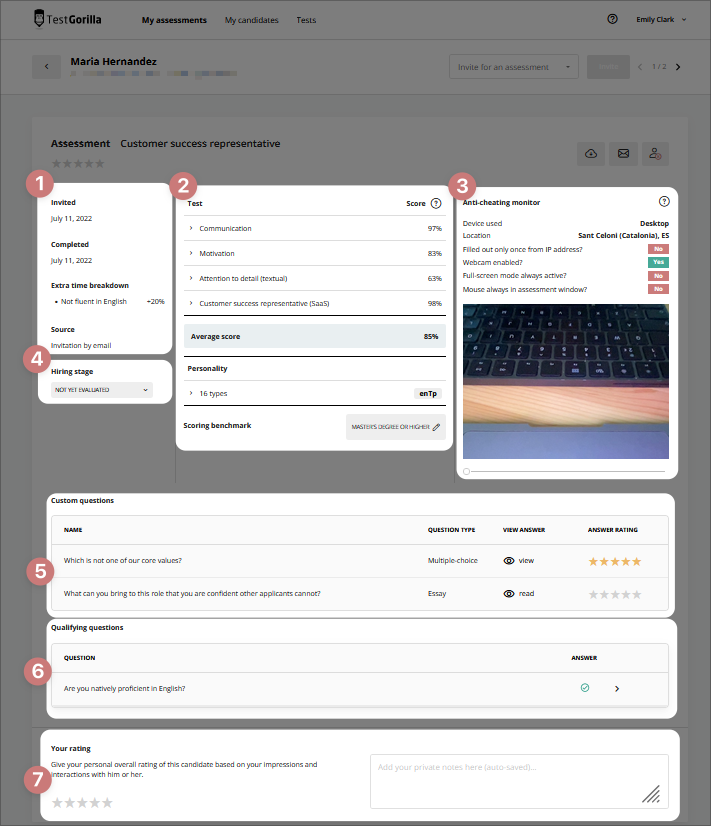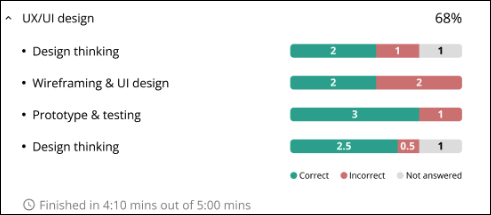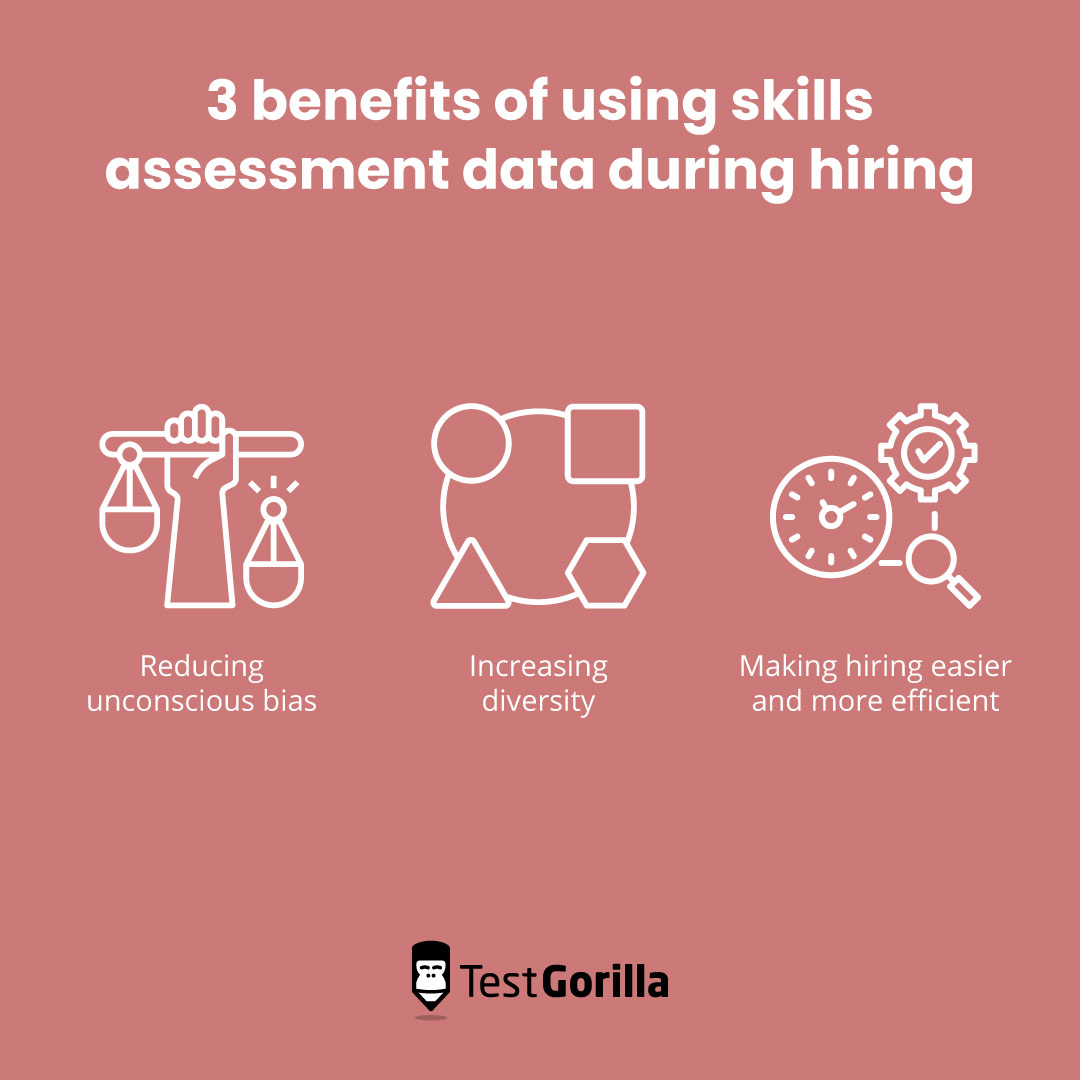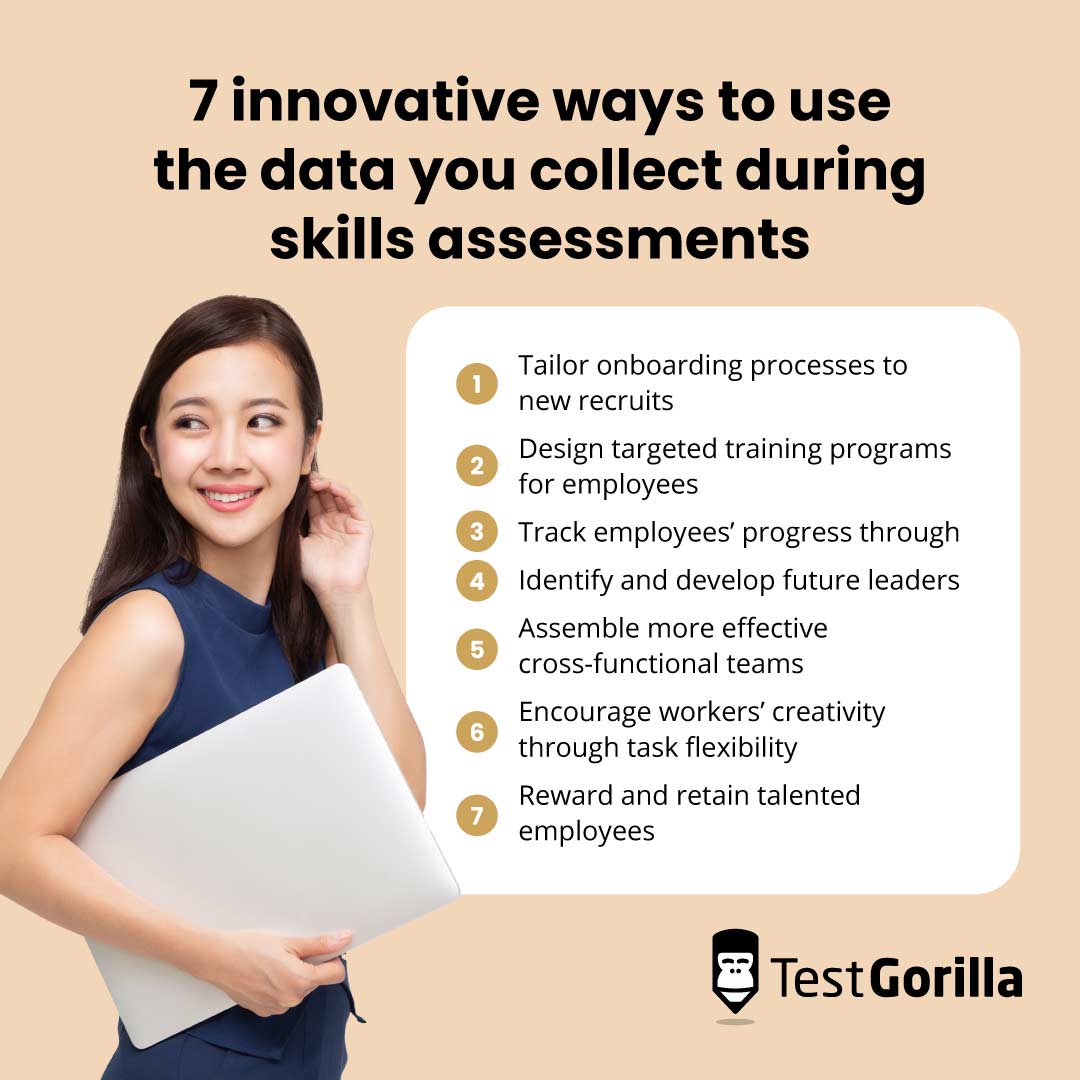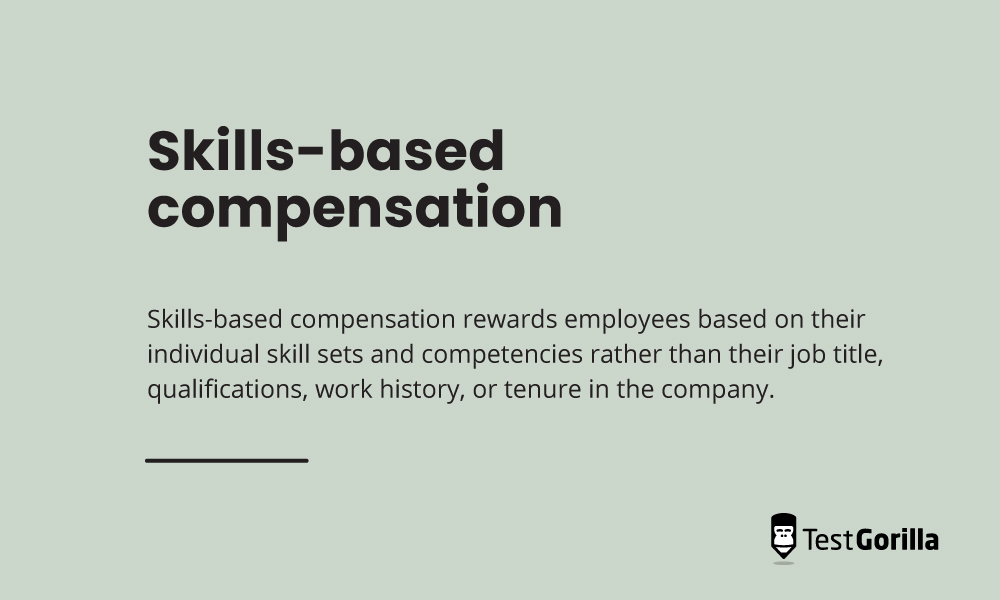7 innovative ways to use the data you collect during skills assessments
Working with data is becoming more common in HR roles – not just in hiring but in learning and development, too.
“People analytics” or “talent analytics” has been used for all sorts of purposes.
For example, Google analyzed employee performance reviews and feedback surveys to understand what made an effective manager and then used this understanding to “build a better boss.”[1]
One of the richest sources of data for HR leaders is skills testing, both at the hiring stage and when developing your workforce.
In this blog, we discuss the most innovative ways you can use data to develop your workforce.
But first, what data does skills testing give you to work with?
Table of contents
- What data do you receive from skills assessments?
- 3 benefits of using skills assessment data during hiring
- 7 innovative ways to use the data you collect during skills assessments after hiring
- How to apply employee skills test data to your strategy
- Start making data-driven HR decisions by assessing your workforce with skills testing
- Sources
What data do you receive from skills assessments?
An employee skills assessment is simply a collection of role-relevant tests that enables you to observe and quantify a candidate’s or an employee’s performance in the key skill areas needed for their role.
Skills assessments are most commonly used in the hiring process. They take an hour or so to complete and are most effective when used in place of outdated tools like the traditional resume.
Let’s take a look at TestGorilla’s talent assessment platform for an example of the kind of data these tests can generate.
Once you’ve collected candidates’ responses on TestGorilla, you’re taken to a results page, where you can see candidates ranked based on their average scores on the tests you’ve set for them. It looks something like this:
When you click on a candidate’s name, you see their full results. That means:
The candidate’s details, like when they completed the test.
A summary of their test results.
The results of the anti-cheating monitor – in other words, if any red flags were raised about whether or not they cheated.
The hiring stage they’re in.
Their answers to custom questions. These might be multiple-choice, essay- or video-based, a sample of code, or a file upload (we’ll discuss these more in just a moment).
Their answers to qualifying questions to check they satisfy the minimum requirements for employment. For example, if you were hiring a truck driver, they would need to have a license for the relevant truck type.
Their overall rating, based on your or another hiring manager’s appraisal.
However, you don’t see the specific questions they answered. This is one of the ways we keep people from cheating on our skills-based tests. By hiding questions even from employers, we reduce the risk of test content being leaked online.
That’s the overview. But it’s also possible to dig deeper into candidates’ scores.
Multiple-choice tests are broken down into various skill areas to display how a candidate performed in certain sections of the test. You can also see how long the candidate took to complete the test. Here’s an example:
It’s also easy to see how candidates’ scores translate to their skill level for other types of questions. Here’s an overview:
Question type | Information given |
Coding tests | The overall score achieved on the test and the time taken to complete it. |
Culture add survey | A percentage score. The higher the percentage, the closer a match they are to your company’s culture. The expanded view shows the score for each section of the survey. |
Motivation test | A percentage score, similar to the culture add score. The higher the percentage, the more aligned your candidate’s motivations are to yours. |
Personality tests | The categorized personality is given. Clicking on this displays a more detailed report. |
3 benefits of using skills assessment data during hiring
Already, we can see how rich the data is that you gain about candidates from administering pre-interview skills assessments.
Naturally, these insights enable you to compare individual candidates more closely – for instance, seeing how they stack up to one another in different skill areas.
This translates into three key benefits to your overall hiring process.
1. Reducing unconscious bias
The first benefit of using skills testing during hiring, particularly in place of a resume, is reducing opportunities for unconscious bias.
These are rife in traditional hiring. One study found applicants with White-sounding names were almost 10% more likely than those with Black-sounding names to receive responses to the exact same applications.
Similar research conducted by Yale University found scientists consistently preferred to hire men over women, even after receiving training on objective hiring.[2]
We don’t believe this is the result of malice on the part of recruiters. Rather, it’s an indication that traditional hiring leaves recruiters without the data support necessary to make fully rational decisions, leaving them to rely on “gut feelings” informed by unconscious biases.
Having the data from skills tests empowers you to make informed decisions and justify every hire with objective data, effectively leveling the playing field.
TestGorilla even lets you change candidates’ scoring benchmarks based on their educational level, background, and level of experience. This means recruiters won’t be dazzled by a fancy degree, instead seeing how impressive a candidate really is based on their own merits.
This approach can bring positive changes to your hiring process.
One study of more than 2,000 successful job applicants found the number of women hired into senior roles increased by nearly 70% when using skills-based hiring methods.
Skills-based hiring also makes recruitment more accurate. Without bias clouding your judgment, you can assess who really has the required skills for the role.
According to our State of Skills Based Hiring 2022 report, 92.5% of organizations saw a reduction in mis-hires after switching to a skills-based hiring process.
2. Increasing diversity
The result of leveling the playing field in hiring is that you create a more diverse workforce. Our State of Skills Based Hiring 2022 report also found that 91.1% of organizations saw an increase in diversity after switching to skills-based hiring methods.
This boost in diversity is good for business. Research by Pipeline found that for every 10% increase in intersectional gender equity, organizations receive a 1%-2% bump in their revenue – and separate research by McKinsey indicates that this relationship has only strengthened over time.[3,4]
This is partly due to the benefits that a diverse range of thinkers can bring to your organization.
Think of it like building the perfect quiz team. If all you had was geography experts, you’d have a terrible time in all but one round. Having a diverse range of specialisms on board can widen the knowledge available to you when problem-solving and boost creativity.
In fact, Deloitte research suggest that diversity of thinking increases innovation by as much as 20%.[5]
Not only does diversity benefit your level of innovation and your bottom line, but it’s also linked to better company culture. Studies have shown that higher levels of gender equity and the presence of HR policies related to this issue are linked to lower turnover in businesses.[6]
3. Making hiring easier and more efficient
If it wasn’t enough that skills testing makes your hiring process fairer and your organization more diverse, it’s also less of a headache than the traditional approach, both in terms of time and resources.
It takes a lot of time for your hiring managers to extract the information they need from the long-standing protocol of sifting through resumes and conducting unstructured interviews. This means making informed hiring decisions is both time- and labor-intensive.
This is likely why a report from the Society for Human Resource Management (SHRM) in 2017 found that the average cost per hire in the US was more than $4,000.[7]
By eliminating the resume and replacing it with skills testing, hiring managers can see relevant, verified information about each candidate’s key skills. These scores are also automatically sorted in order of promise, making shortlisting light work.
This remains true even when you’re hiring for a role you have less experience with. TestGorilla enables you to benchmark candidates’ scores by comparing them to other groups of candidates on our database, so even if you’ve never hired for this role before, you can make sure their skills are up to par.
TestGorilla also lets you, or another stakeholder, rate and leave comments on candidates’ answers to questions. This gives you an additional dataset: your personal evaluation of their fit for the role.
Let’s say you’re hiring for a highly technical role you have little direct experience in. You might create a shortlist using skills testing and informed by industry benchmarks. Then you would ask the head of the team to personally evaluate each candidate’s scores to create a final shortlist.
It’s easy to see how this increases hiring speed and cost-efficiency. Our own report found that 89.8% of organizations saw a reduction in cost-to-hire and 91.4% saw a reduction in time-to-hire after they started using skills-based methods.
The best insights on HR and recruitment, delivered to your inbox.
Biweekly updates. No spam. Unsubscribe any time.
7 innovative ways to use the data you collect during skills assessments after hiring
We’ve seen how using skills-based hiring data can inform your hiring decisions, but how can you use it after hiring?
Here are seven innovative uses for skills test data.
7 innovative ways to use the data you collect during skills assessments: Summary table
Already have all your test data and want to hit the ground running? Here’s the quick version of our tips below.
Innovative ways to use skills test data | Example actions |
Tailor onboarding processes to new recruits | Use personality test results to determine how best to teach new recruits – e.g. through independent worksheets vs. one-to-one instruction |
Design targeted training programs for employees | Identify candidates’ weaker skill areas and create plans to upskill them in these abilities |
Track employees’ progress through training schemes | Re-test employees at intervals throughout training programs and use the data to map their progress |
Identify and develop future leaders | Periodically test all employees for leadership and management skills and nurture those who show natural ability |
Assemble more effective cross-functional teams | Create well-rounded cross-functional teams with less conflict by looking at not just skills, but personality types |
Encourage workers’ creativity through task flexibility | Use your understanding of workers’ adjacent skills from skills testing to move them onto projects outside of their core competencies |
Reward and retain talented employees | Switch to skills-based compensation, paying workers for their skill level and not their experience |
1. Tailor onboarding processes to new recruits
Too often, onboarding checklists focus on paperwork. This is very short-sighted: The introduction an individual gets to your organization is instrumental in determining their longevity at your company, and it goes far beyond filling in forms and reading how-to guides.
Research shows new hires are twice as likely to plan to leave if their onboarding experience is bad. You do not want to take that risk.[8]
Start by including personality tests – for example, an Enneagram test – in your pre-interview assessments. At TestGorilla, we supply tips on working with each personality type along with test results and even suggest interview questions based on each personality.
You can then use this information to determine the best delivery method for onboarding.
For instance, you can see whether recruits should work through instructions by themselves or if they would prefer a more hands-on approach with personal introductions from team members.
You could also use their performance in different areas of the skills test to give them extra support. If an otherwise strong recruit has weaker Excel skills, for example, you could include a quick primer in your onboarding process, emphasizing the key functions they’ll need in their role.
2. Design targeted training programs for employees
Perhaps the most powerful thing to use skills test data for is to design targeted training programs for employees. Use your knowledge of their weaker skill areas to target their training from the start of their employment.
Like good onboarding, this can aid retention. The number one reason people leave their jobs is a lack of learning and development opportunities, so making sure you deliver these – and well – is a must.
Skills tests can also be used to proactively address internal skills gaps by identifying which employees will require upskilling to meet changing skills requirements.
As well as aligning your skills resources with your upcoming skills needs, proactively designing training plans can also help you respond to skills shortages.
Skills shortages are skills gaps beyond your control as an employer because they don’t just exist in your company but in your wider talent pool. This might be because they’re in short supply in your industry or your geographical region.
In 2022, three-quarters of employers worldwide reported talent shortages, the highest figure in 16 years.[9]
By being proactive about employee upskilling, you can hire candidates who have most of the skills you need and train them to develop the rest. This reduces your costs because less-skilled candidates are likely less in demand and less expensive.
It also brings other benefits: 93% of chief executive officers who introduce upskilling programs see increased productivity, an improvement in talent acquisition and retention, and more resilience in their workforce.[10]
The targeted approach we recommend here supercharges these efforts. When organizations align their HR processes to match the skills needed in their workforce, employee engagement receives a boost of 50%, training and development costs halve, and productivity goes up by 40%.[11]
3. Track employees’ progress through training schemes
So far, we’ve discussed what you can do with the information you’ve gained when screening candidates with one introductory skills test.
However, you can also re-administer skills tests throughout training programs to gauge the success of those programs and see how quickly employees’ skills are developing.
For example, you might choose to provide a candidate with training in the Python coding language because they only scored 50% on their entrance test. As they progress through training, you could watch how this number climbs by giving them the same test over again.
This data can help you maximize the value of your investment in learning and development initiatives in many ways:
Comparing different training providers to see which gives the best results, fastest
Monitoring employees’ development to ensure they don’t plateau
Demonstrating the quality of your initiatives to leaders to lobby for more investment
4. Identify and develop future leaders
You should also routinely test employees for overall leadership and managerial skills.
This can be a great way of identifying potential leaders, a practice with benefits for retention and engagement.
A study by SHRM revealed that while employees who don’t move jobs internally are only 45% likely to stay long-term, those who are promoted within three years of hiring are 70% likely to stay on board. Those who make lateral moves are 62% likely to stay.[12]
Just as skills testing makes hiring fairer and less biased, it can also make internal promotion fairer by providing decision-makers with data from which to make promotion decisions.
This circumvents the unconscious bias and cronyism that can occur when leaders are left without data support. Research shows that female employees are less likely to be promoted than their male colleagues, despite outperforming them and being less likely to quit.
For best results, when building professional development plans for each employee, don’t just look at individuals’ potential to grow vertically. Keep an eye out for lateral moves, too. That means looking at their trainability and their ability to evolve, as well as any skills that overlap with other teams.
5. Assemble more effective cross-functional teams
Skills-based hiring is effective partly because it helps employers target the core skills needed for any given role. It also gives you a means of observing candidates’ strengths in adjacent skills that could align with other teams and projects within your organization.
For instance, a salesperson might have excellent written communication and strategy skills they could use to help your marketing team devise new messaging.
You can use this information about overlapping skills to drive innovation by putting together complementary cross-functional teams.
These are a hallmark of innovative organizations. According to Deloitte research, 83% of digitally maturing companies use cross-functional teams, compared to just 55% of early-stage organizations.[13]
The key word here is “complementary.”
Cross-functionality alone does not lead to innovation. In fact, 2015 research found that three-quarters of cross-functional teams were dysfunctional, failing in key tasks like:
Meeting a planned budget
Hitting deadlines
Meeting specifications
Measuring up to customer expectations
Aligning with overall corporate goals
The research found that these failures were due to four systemic issues:
Unclear governance
A lack of accountability
Goals that lack specificity
Organizations’ failure to prioritize the success of cross-functional projects[14]
The data from skills tests can help you address these issues and ensure your cross-functional teams run smoothly by using personality tests to assemble complementary individuals.
6. Encourage workers’ creativity through task flexibility
In a similar vein, skills testing can be a great way to gain confidence in your workers.
First, it helps you identify internal experts who score especially highly on skills tests. You can then use these employees as expert consultants on other teams, bolstering their confidence and maximizing their value to your workforce.
After using skills testing to drill down into workers’ existing skills, you can use it to expand their repertoire by identifying their adjacent skills. These are skills related to their core competencies that they might not be as strong in.
The ultimate goal of these initiatives is to empower you to give employees more autonomy and flexibility when it comes to choosing the projects they’re involved with and the approaches they use to problem-solve.
This can be greatly beneficial. Most workers lack autonomy in their day-to-day work, which has many negative impacts on their performance and their wellbeing.
In a study of healthcare workers, those with low autonomy were 84% more likely to report poor health and a whopping 163% more likely to report burnout, compared to those with medium-level job autonomy.
By contrast, increasing employees’ autonomy has been shown to improve:
Role clarity by 20%
Engagement and commitment by 17%
Satisfaction and alignment by 15%
Social safety by 15%
Adaptability by 11%[15]
Allowing workers to apply their skills creatively to different projects fulfills their needs while also creating a more agile workforce.
7. Reward and retain talented employees
So far, we’ve seen that skills testing gives employers a means of:
Identifying future leaders
Designing training plans
Tracking candidates’ skill development
All of this is essential when it comes to effectively rewarding and retaining top talent. The best way to make employees feel valued and make them want to stick around is by investing in their skills and engaging in their career journeys.
Astonishingly few managers do this. According to research by McKinsey, 41% of team leaders don’t support, consult, or challenge their teams on a regular basis. The result? Just 27% of their employees report a positive climate within their team.
Many of the initiatives we’ve already described are perceived as rewards by employees – for instance, leadership training. However, you might take things a step further.
One way to do this is with skills-based compensation. Skills-based compensation refers to paying employees based on their skill level rather than their experience or job title. Its goal is to encourage upskilling and reskilling and to create a culture of continuous learning.
If you’ve already implemented the strategies above and want to put your money where your mouth is when it comes to the skills-based approach, this is a great option.
How to apply employee skills test data to your strategy
The above strategies all require a certain level of infrastructure to get off the ground.
If you’re just getting started with skills testing, here’s how you get there.
Step 1: Create a skills taxonomy
First, you need to identify the skills most crucial to success in your organization. To do this, look at different sources:
Skills test data. Examine the skills of the highest-performing teams in your organization. Do they all score highly when it comes to communication? Problem-solving? What’s the right skills mix for success in your business?
Industry benchmarks and data. Look at the skills resources represented by your competitors and pay particular attention to the skills that aren’t present in your organization.
Interviews and consultations with business and industry experts. Raw data can only take you so far; sometimes, it takes someone with an intimate understanding of the industry to tell you why the particular mix of skills you’re looking for works.
With this in mind, create a skills taxonomy. This is a structured list of key skills required at all levels of the business to enable its success:
Step 2: Collect your data
The next step is to collect data from your employees.
This requires a broader data collection approach than you applied in the last step – ideally, collect data from as many employees as possible.
There are a few key things to remember when doing this.
First, be mindful of the data laws in your region. In the UK or European Union, look up the General Data Protection Regulations (GDPR); in the US, check your state legislature.
Secondly, minimize the effort required from each employee. Use their entrance tests where possible and only administer one assessment in any given period – say, per year.
Thirdly, clearly communicate what the data will be used for and what benefit they will gain from it, like better-tailored development plans.
A survey of more than 10,000 workers and 1,400 C-level executives across 13 countries and 13 industries found that more than 90% of the employees are willing to let their employers collect and use data on them and their work – but only if they benefit in some way.[16]
Finally, collate the data into an internal talent marketplace: a piece of software or a spreadsheet that contains all the skills information for your organization and that you can use to “shop” the right skills for a given role or project.
There are many different sources of data available to you. For more info, check out our article on six ways big data can help your recruitment strategy.
Step 3: Conduct a skills-gap analysis
Looking at your internal talent marketplace, conduct a skills-gap analysis to determine which skills are missing from your workforce.
Skills gaps are more common than you think: Nearly 60% of the workforce already need new skills to do their jobs effectively.[17]
Once you’ve identified the skills lacking in your organization, underline the ones that are also listed in your skills taxonomy. These are the ones impacting your performance the most.
When this is done, you can prioritize which skills gaps need to be plugged the fastest, using the data-driven strategies outlined above to make this happen. When done right, you cater to the needs of your employees while also improving productivity in your workforce.
Step 4: Determine where to hire, upskill, or redeploy
Finally, using your newfound understanding of where the skills gaps lie in your business – and the skills resources already available to you in your workforce – identify whether the solution to these gaps is to:
Hire a new person who fits the skills brief
Upskill an existing employee who has most of the other skills you’re looking for already
Redeploy an employee from another team who has adjacent skills
In cases where just one key skill is missing in a team, you might choose to fill this gap by upskilling an existing member of that team.
For example, you might do this if a team of web developers had all the key technical skills required for their roles but lacked project management skills. In this case, you might upskill and promote the team leader to be a better project manager.
There may also be cases where a bigger skills gap exists, but hiring external candidates is challenging due to skills shortages or a lack of funding for hiring costs. When this happens, consider redeploying someone from another team and using skills training to help them transition.
This could be a temporary or permanent solution. To choose the best candidates, use your internal talent marketplace to identify those with overlapping or adjacent skills.
This is a particularly effective tactic in a period of cost-cutting because it means you only need to turn to external candidates when absolutely necessary, saving you time and money.
Should you turn to external hiring, you’ll know exactly what to look for thanks to the key skills outlined in your skills taxonomy and the missing skills shown in your skills-gap analysis. You’ll even have the tools to build a strong personal development plan.
You’ll be ready for anything.
Start making data-driven HR decisions by assessing your workforce with skills testing
As we’ve seen, skills testing can show you the holes in your workforce you didn’t know were there and help you fill them with the right people without being swayed by bias.
It can also help you nurture these employees to ensure your company doesn’t sicken with a toxic culture or develop the same skills gaps all over again in a few months.
We’ve given you the instructions – now it’s up to you to get started.
For an introduction to skills-based recruitment, read our blog about how to adopt skills-based hiring practices.
For a deep dive into using skills testing in your current workforce, read our guide to assessing the skills of your employees.
Or, to get started with strategy number four, use our Leadership and People Management test to identify your future executives.
Sources
Bryant, Adam. (March 12, 2011). “Google’s Quest to Build a Better Boss”. New York Times. Retrieved June 26, 2023. https://www.nytimes.com/2011/03/13/business/13hire.html
Agarwal, Pragya. (December 3, 2018). “Unconscious Bias: How It Affects Us More Than We Know”. Forbes. Retrieved June 26, 2023. https://www.forbes.com/sites/pragyaagarwaleurope/2018/12/03/unconscious-bias-how-it-affects-us-more-than-we-know/?sh=3333fe6e13e7
“Accenture Makes Strategic Investment in Pipeline to Accelerate Gender Parity in the Workplace”. (August 6, 2021). Accenture. Retrieved June 26, 2023. https://newsroom.accenture.com/news/accenture-makes-strategic-investment-in-pipeline-to-accelerate-gender-parity-in-the-workplace.htm
Dixon-Fyle, Sundiatu, et al. (May 19, 2020). “Diversity wins: How inclusion matters”. McKinsey. Retrieved June 26, 2023. https://www.mckinsey.com/featured-insights/diversity-and-inclusion/diversity-wins-how-inclusion-matters
Bourke, Juliet. (January 22, 2018). “The diversity and inclusion revolution: Eight powerful truths”. Deloitte Review. Retrieved June 26, 2023. https://www2.deloitte.com/us/en/insights/deloitte-review/issue-22/diversity-and-inclusion-at-work-eight-powerful-truths.html
“The diversity and inclusion revolution: Eight powerful truths”. (June 24, 2020). Catalyst. Retrieved June 26, 2023. https://www.catalyst.org/research/why-diversity-and-inclusion-matter/
“SHRM Customized Talent Acquisition Benchmarking Report”. (2017). Society for Human Resource Management. Retrieved June 26, 2023. https://www.shrm.org/ResourcesAndTools/business-solutions/Documents/Talent-Acquisition-Report-All-Industries-All-FTEs.pdf
Bolden-Barrett, Valerie. (May 3, 2018). “New hires are twice as likely to leave employers that mishandle the onboarding process”. Industry Dive. Retrieved June 26, 2023. https://www.hrdive.com/news/new-hires-are-twice-as-likely-to-leave-employers-that-mishandle-the-onboard/522384/
“The Talent Shortage”. (2022). ManPowerGroup. Retrieved June 26, 2023. https://go.manpowergroup.com/talent-shortage
“Upskilling’s impact on learning, talent retention and talent acquisition”. PwC Proedge. Retrieved June 26, 2023. https://proedge.pwc.com/upskilling-and-talent-strategies
Jost, Gregor, et al. (May 23, 2022). “Using skill gap assessments to help future-proof your organization”. McKinsey. Retrieved June 26, 2023. https://www.mckinsey.com/capabilities/people-and-organizational-performance/our-insights/the-organization-blog/using-skill-gap-assessments-to-help-future-proof-your-organization
Maurer, Roy. (March 15, 2020). “Study: Internal Mobility Boosts Retention”. Society for Human Resource Management. Retrieved June 26, 2023. https://www.shrm.org/resourcesandtools/hr-topics/talent-acquisition/pages/internal-mobility-boosts-retention.aspx
Kane, Gerald, et al. (October 26, 2021). “Teaming your way through disruption”. Deloitte Insights. Retrieved June 26, 2023. https://www2.deloitte.com/uk/en/insights/topics/strategy/cross-functional-collaboration.html
Tabrizi, Behnam. (June 23, 2015). “75% of Cross-Functional Teams Are Dysfunctional”. Harvard Business Review. Retrieved June 26, 2023. https://hbr.org/2015/06/75-of-cross-functional-teams-are-dysfunctional
Metin, Baran. (August 23, 2019). “HR analytics: autonomy and employee engagement”. Effectory. Retrieved June 26, 2023. https://www.effectory.com/knowledge/hr-analytics-autonomy-and-employee-engagement/
Shook, Ellyn; Sage-Gavin, Eva; Cantrell, Susan. (February 15, 2019). “How Companies Can Use Employee Data Responsibly”. Harvard Business Review. Retrieved June 26, 2023. https://hbr.org/2019/02/how-companies-can-use-employee-data-responsibly
“Gartner HR Research Finds 58% of the Workforce Will Need New Skill Sets to Do Their Jobs Successfully”. (February 4, 2021). Gartner Newsroom. Retrieved June 26, 2023. https://www.gartner.com/en/newsroom/press-releases/2021-02-03-gartner-hr-research-finds-fifty-eight-percent-of-the-workforce-will-need-new-skill-sets-to-do-their-jobs-successfully
You've scrolled this far
Why not try TestGorilla for free, and see what happens when you put skills first.


